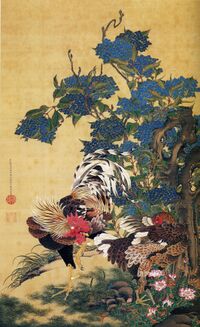Detailed painting
From Nookipedia, the Animal Crossing wiki
| ||||||
 | ||||||
| Real-world counterpart | ||||||
|---|---|---|---|---|---|---|
| Rooster and Hen with Hydrangeas | ||||||
| Year | Unknown | |||||
| Artist | Itō Jakuchū | |||||
| Main appearances | ||||||
|
| ||||||
Name in other languages
ちみつなめいが
细致的名画 Toile détaillée Cuadro detallado Quadro dettagliato Детальная картина
섬세한 명화 細緻的名畫 Toile détaillée Cuadro detallado Detailgemälde Gedetailleerde schilderij | ||||||
The Detailed Painting (commonly known as Rooster and Hen with Hydrangeas in the real world) is a painting first introduced in Animal Crossing: New Horizons. One of Itō Jakuchū's most ambitious endeavors, and therefore most famous works. Begun around 1757 and not finished until 1765, the Pictures are a set of twenty-seven hanging scrolls created as a personal offering to the Shōkoku-ji temple. They depict a number of animal subjects in monumental scale and with an according degree of detail.
Painting information
In New Horizons
| Museum description | A detailed, colorful, and dynamic piece by Itō Jakuchū, a successful Kyoto artist in the mid-Edo period. High-quality paints on silk help it maintain its brilliant color even now, 200 years after its creation. |
|---|---|
| Buy price | |
| Sell price | |
| Obtain from | |
| Authenticity | Unknown |
| Furniture size |
- ↑ Cannot be sold if it is a forgery.
Authenticity
In New Horizons, if the flowers are purple and no stamps is on the left, it is the forgery.
This image is an illustration of a scene or object from a video game.
The copyright for it is most likely owned by either the publisher/producer and/or artist(s) producing the work in question. It is believed that the use of web-resolution images of artwork for commentary on the scene or object in question qualifies as fair use under United States copyright law. See Wikipedia:Fair use for more information.
This image is an illustration of a scene or object from a video game.
The copyright for it is most likely owned by either the publisher/producer and/or artist(s) producing the work in question. It is believed that the use of web-resolution images of artwork for commentary on the scene or object in question qualifies as fair use under United States copyright law. See Wikipedia:Fair use for more information.